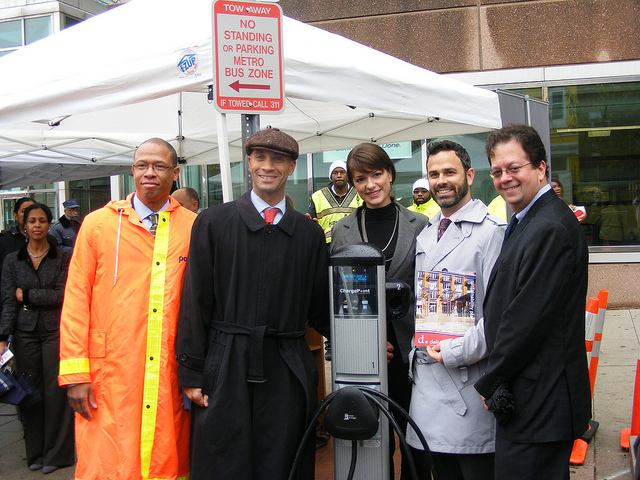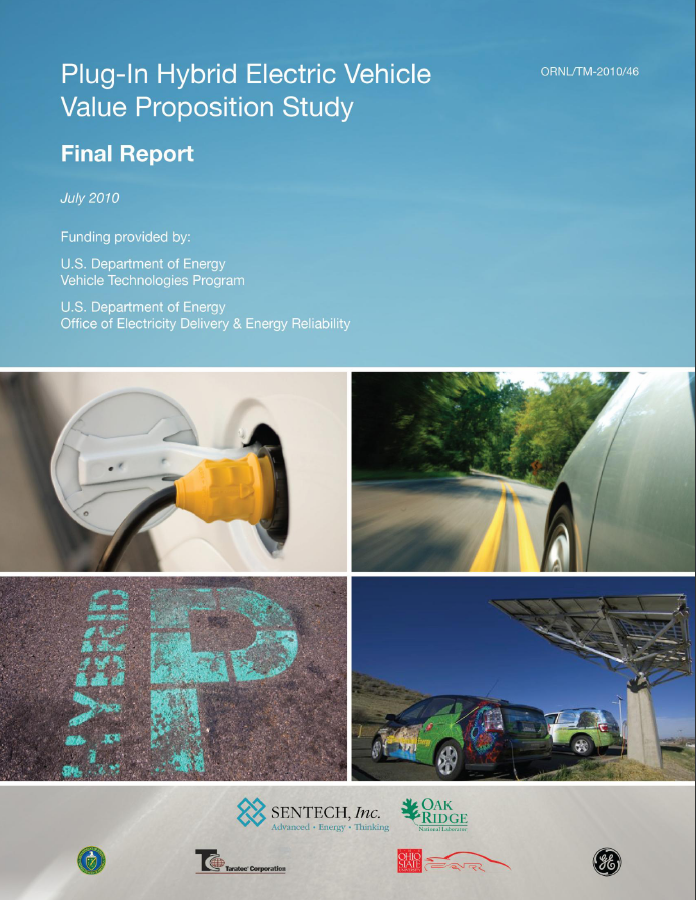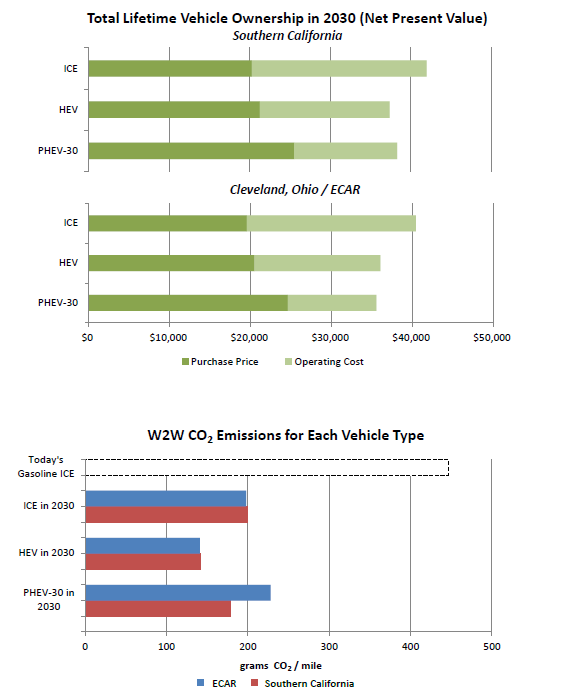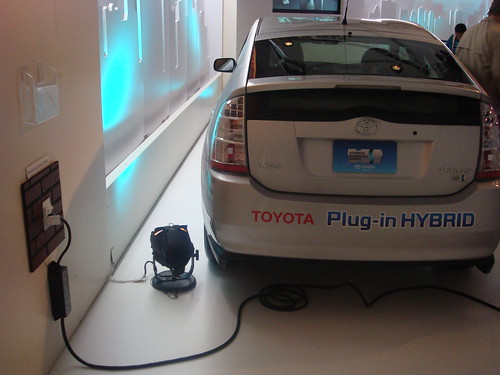Publication Alert: An Action Plan to Integrate Plug-In Electric Vehicles with the U.S. Electrical Grid
(Source: AASHTO)
Recently found this nice 62-page report on vehicle electrification via an AASHTO e-mail and felt compelled to share. Here are some excerpts from the AASHTO Journal:
Plug-in electric vehicles can lessen U.S. dependence on imported oil, address rising gas prices, enhance air quality, and reduce greenhouse-gas emissions, but their full potential will only be realized through a broad-based group of stakeholders working together, concludes a report released Tuesday by the Center for Climate and Energy Solutions and co-sponsored by AASHTO’s Center for Environmental Excellence.
The report presents several recommendations from a coalition that includes automakers, electrical utilities, environmental groups, and state officials. Coordinated public and private actions at the state and local levels can help ensure that plug-in owners are able to more readily charge their vehicles without overburdening the electric grid, the report states.
Recommendations include encouraging state public utility commissions and other policymakers to set up a consistent regulatory framework across the nation to better synchronize technical standards; streamlining the establishment of changing stations in both home and commercial settings; leveraging electricity rate structures to promote charging at off-peak times; helping local policymakers and other stakeholders in the appraisal of needs in their jurisidictions; strategically targeting public and private investments in related infrastructure; and providing credible information on the costs, benefits, and choices involving plug-ins.
[scribd id=85636602 key=key-2n0xv981yvwrrne389q8 mode=list]
Finally! Washington, DC Unveils First Public Curbside ChargePoint Charging Station
Washington, DC’s first public curbside 240V Level II Coulomb ChargePoint station is now located at the Franklin D. Reeves Center, 2000 14th Street, in northwest DC. There are two spaces available for charging vehicles on the west side of 14th Street adjacent to the Reeves Center. The installation of the ChargePoint station was done by PEPCO and Coulomb distributor NovaCharge, LLC.
Mayor Adrian M. Fenty today, along with the Department of Energy Undersecretary Cathy Zoi, District Department of Transportation Director Gabe Klein and other officials unveiled the first curbside electric car charging station in the District.
“This is yet another fantastic way the District is at the forefront of providing alternative and environmentally friendly transportation options for District residents and visitors,” said Mayor Fenty. “We are excited to make this technology available and easily accessible to everybody.”
Click here to read the full story.
Related articles
New Study Report Makes a Strong Case for Plug-In Hybrid Electric Vehicles
The U.S. Department of Energy’s Alternative Fuels and Advanced Vehicles Data Center has released a report that evaluates value-added propositions for plug-in hybrid electric vehicles (PHEVs) that might help overcome the initial price premium related to comparable internal combustion engine and hybrid electric vehicles. The report also assesses other non-monetary benefits and barriers related to an emerging PHEV fleet, including environmental, societal, and electric grid impacts.
Here is a quick peek into the study’s background, objectives, results and conclusions as shown in the fact sheet:
- To identify and evaluate value-added propositions for PHEVs that will help overcome the initial price premium relative to comparable ICEs and HEVs and
- To assess other non-monetary benefits and barriers associated with an emerging PHEV fleet, including environmental, societal, and grid impacts.
Results:
Study results indicate that a single PHEV-30 on the road in 2030 will:
- Consume 65% and 75% less gasoline than a comparable HEV (Hybrid Electric Vehicle) and ICE (Internal Combustion Engine), respectively.
- Displace 7.25 and 4.25 barrels of imported oil each year if substituted for equivalent ICEs and HEVs, respectively, assuming 60% of the nation’s oil consumed is imported.
- Reduce net ownership cost over 10 years by 8-10% relative to a comparable ICE and be highly cost competitive with a comparable HEV.
- Use 18-22% less total W2W energy than a comparable ICE, but 8-13% more than a comparable HEV (assuming a 70/30 split of E10 and E85 use in 2030).
- Emit 10% less Well to Wheel (W2W) CO2 than equivalent ICEs in southern California and emits 13% more W2W CO2 than equivalent ICEs in the ECAR region. This also assumes a 70/30 split of E10 and E85 (ethanol blends) use in 2030.
Conclusions:
PHEVs and other plug-in vehicles on the road in 2030 may offer many valuable benefits to utilities, business owners, individual consumers, and society as a whole by:
- Promoting national energy security by displacing large volumes of imported oil.
- Supporting a secure economy through the expansion of domestic vehicle and component manufacturing.
- Offsetting the vehicle’s initial price premium with lifetime operating cost savings (e.g., lower fuel and maintenance costs).
- Supporting the use of off-peak renewable energy through smart charging practices. However, smart grid technology is not a prerequisite for realizing the benefits of PHEVs.
- Potentially using its bidirectional electricity flow capability to aid in emergency situations or to help better manage a building’s or entire grid’s load.
PHEVs and other plug-in vehicles still face barriers to commercial acceptance:
- In the near term, the cost of energy storage, charging equipment, and PE&EM components must continue to descend to competitive levels, such as the ones assumed in this study. Industry trends imply that these cost reductions are on track to reach competitive price levels.
- PHEVs’ inability to reduce carbon emissions relative to ICEs unless they are powered primarily by non-carbon energy sources. A grid-connected vehicle’s high dependence on its region’s generation mix is very evident in this study’s findings. Operating in regions with a high percentage of non- or low-carbon energy sources (e.g., renewable, nuclear, and natural gas) would ultimately help improve the long-term environmental impacts of PHEVs.
Note: The Acronym PHEV-30 stands for Plug-in Hybrid Electric Vehicle with an All Electric Range (AER) equivalent of 30 miles.
Click here to download/access the entire report (PDF – 218 pages long).
Related articles
- Study Finds Public Policies Needed to Boost EV Fleet Purchases (environmentalleader.com)
- Electric Vehicle Sales in Asia Pacific to Total 1.4 Million by 2015, Forecasts Pike Research (eon.businesswire.com)
- Electrification Coalition Releases Plan for 16M Electric Fleet Vehicles (solarfeeds.com)
- “Plug-in Prius is NOT a plug-in hybrid electric vehicle!” and related posts (hybridcarblog.com)
- Pike survey finds unproven technology and reliability concerns may hinder consumer demand for plug-in electric vehicle, although about 44% of respondents are interested in purchasing one (greencarcongress.com)
- Reportlinker Adds Hybrid Electric Vehicles for Fleet Markets (prnewswire.com)
- 3.2 Million Plug-in Electric Vehicles to be Sold Worldwide by 2015, Forecasts Pike Research (eon.businesswire.com)
- Electrification Coalition releases Fleet Electrification Roadmap; suggests fleet adoption could put a cumulative 200,000 PHEVs and EVs on the road by 2015 (greencarcongress.com)
- Pike forecasts Asia-Pacific to be largest PEV market, with more than 1.2M units by 2015; China to represent 53% of total sales (greencarcongress.com)
- Bloomberg New Energy Finance forecasts plug-in electric vehicles could account for up to 9% of US auto sales in 2020 and 22% in 2030 (greencarcongress.com)
- J.D. Power forecasts hybrid- and battery-electric vehicles will represent 7.3% of global auto sales in 2020 (greencarcongress.com)
- Hybrid Fleet Vehicle Sales to Surpass 740,000 Units per Year in 2015, According to Pike Research (eon.businesswire.com)
- Plug-In EV Market to Sell 3.2M Units by 2015 (environmentalleader.com)
- BeFrugal.com Proposes Cost Equivalent MPG Calculation for Electric Vehicles (prnewswire.com)
Uncle Sam goes for a pricey “green & clean” image makeover – GSA Offers 5,600 Hybrids (Including 100 Plug-In Hybrids) To Federal Agencies
(Source: Edmunds.com, Green Car Congress & Federal Times)

Image Courtesy: via Apture
The US government’s General Services Administration (GSA) this summer took delivery of the first of more than 5,600 hybrid vehicles ordered earlier this year, and will make the vehicles—almost all of which are Ford Fusion hybrids—available to various federal agencies under GSA lease agreements as they are delivered.
GSA previously purchased 1,600 hybrid vehicles using revenue from the sale of older vehicles that agencies exchanged last year when they received funds for new vehicles through the American Reinvestment and Recovery Act (ARRA) of 2009.
GSA director of Motor Vehicle Management Bill Toth noted, however, that each Fusion hybrid costs $11,214 more than the fleet’s “non-hybrid alternative” sedan, a 2010 Chrysler Avenger.
But due to the $11,214 hybrid premium of the fuel-efficient Fusion, Toth said, he doesn’t “know that we’ll see the numbers we’ve seen in the last two years continue at that pace without some sort of infusion of capital.
“They’re very expensive vehicles and when you look at meeting your mission … and one [vehicle] is $10,000 cheaper than the other, capital’s limited. It’s tough to make that jump,” he said.
Almost all of the hybrids the GSA purchased are 2010 Ford Fusion Hybrids , a mid-sized sedan that’s second in class in fuel efficiency only to the Toyota Prius. The Fusion get 39 mpg in combined city and highway driving and emits 4.8 tons of carbon dioxide annually, or 2.7 tons less than the nonhybrid version.
The vehicles will be placed in clusters near where manufacturers are delivering them to ensure that the vehicles can be serviced by mechanics trained in the new technology, Toth said.
Charging stations will be installed where the vehicles will be housed, and GSA is exploring the potential to partner with industry or other users to share the expense of installing the stations. GSA also hopes to pilot different energy sources for the stations, including solar and wind power in addition to standard electric power, he said.
Related articles by Zemanta
- GSA To Make 5,600 Hybrids Available To Federal Agencies, Including 100 Plug-In Hybrids; Cost Still An Issue (greencarcongress.com)
- Enova Secures United States General Services Administration (GSA) Exclusive Contract to Supply the Enova Ze: All-Electric, Walk-In Step Van (eon.businesswire.com)
- GSA Proposes Zero Environmental Footprint (greenbuildinglawupdate.com)
NYT’s alternative fuel research round up – Finding New Ways to Fill the Tank – Beyond fossil fuels
Whatever be the alternative, it has to get here quickly for two reasons — first is the economic factor (reliance on foreign oil is costing a lot for us) and the second is the environmental impact factor.. Glad to see the public and private sector working hand in hand to bring these solutions to the consumers.. I’m betting big on battery technology, which has the potential to revolutionize the way we travel.
CAMBRIDGE, Mass. — Most research on renewable energy has focused on replacing the electricity that now comes from burning coal and natural gas. But the spill in the Gulf of Mexico, the reliance on Middle East imports and the threat of global warming are reminders that oil is also a pressing worry. A lot of problems could be solved with a renewable replacement for oil-based gasoline and diesel in the fuel tank — either a new liquid fuel or a much better battery.
Yet, success in this field is so hard to reliably predict that research has been limited, and even venture capitalists tread lightly. Now the federal government is plunging in, in what the energy secretary, Steven Chu, calls the hunt for miracles.
The work is part of the mission of the new Advanced Research Projects Agency – Energy, which is intended to finance high-risk, high-reward projects. It can be compared to the Defense Advanced Research Projects Agency, part of the Pentagon, which spread seed money for projects and incubated a variety of useful technologies, including the Internet.
The goal of this agency, whose budget is $400 million for two years, is to realize profound results — such as tens of millions of motor vehicles that would run 300 miles a day on electricity from clean sources or on liquid fuels from trees and garbage.
National Renewable Energy Laboratory Publication – Plug-in Electric Vehicle Infrastructure: A Foundation for Electrified Transportation
(Source: via Transportation Research Board Weekly E-Newsletter)
The National Renewable Energy Laboratory has released a report that explores the components of plug-in electric vehicle infrastructure, challenges and opportunities related to the design and deployment of the infrastructure, and the potential benefits.
Questionable future? Recharging and other concerns keep electric cars far from mainstream
(Source: Washington Post)
It was dark and rainy, and the battery on his nifty Mini E electric car was almost gone.
Paul Heitmann rolled quietly through the suburban New Jersey gloom, peering through the rain on the windshield, not sure what he was looking for, anxiety turning into panic. He needed juice. He spotted a Lukoil gas station, which was closed, and beside the point, anyway. But beyond the pumps, there was a Coke machine, and it was lit up.
“I thought ‘Finally!’ because I knew if there was light, there would be electricity,” he said. “I managed to find the outlet behind the Coke machine and plugged in.”
As many of the auto companies tell it, next year may be the year that the massive U.S. auto industry really begins to go electric.
The all-battery Leaf from Nissan is scheduled to go on sale in November. General Motors will begin selling the Chevy Volt, a primarily electric car (with a small auxiliary gasoline engine that kicks in to boost the car’s range). Ford has plans to produce an electric commercial van. The Obama administration has doled out $2.4 billion to companies involved in producing batteries and other parts of electric cars.
“We have to get on with the electrification of our industry,” William Clay Ford Jr., chairman of Ford, said during a visit to Washington on Monday.
“I know we have to have an electric car,” GM Chairman Edward E. Whitacre Jr. told reporters last week.
But overshadowing prospects for the transition of the vast U.S. auto fleet to electric — and the billions of dollars the automakers have invested in the switch — is the question of whether anyone beyond a sliver of enthusiasts will soon embrace the newfangled cars, which force drivers to rethink their habits and expectations of convenience.
Click here to read the entire article.
Ars Technica: Carbon nanotubes may power ultracapacitor car
(Source: Ars Technica; CNET)
At Technology Review’s EmTech conference last week, MIT professor Joel Schindall told the audience at a panel on energy storage why ultracapacitors may have a significant role to play in our transportation future. The good properties of these devices—fast charge/discharge cycles and an essentially unlimited number of cycles—make them a compelling choice for powering an electric vehicle. Schindall also explained why their downside, a far lower charge density than batteries, might not be as much of a problem as it might appear at first glance.
Schindall, who had spent some time away from academics, explained that during his first stint at MIT, a capacitor that could hold 350 Farads would have filled the whole stage. Before he returned, someone working on fuel cells had accidentally produced the first ultracapacitor. Now, with refinements, he was able to walk on stage with a 350 Farad ultracapacitor that was about the size of a D battery. The current generation of devices use activated carbon to hold charges, as its highly complex topology creates a lot of surface area across which charge differences can build up.
Although the improvements have been dramatic, Schindall said that ultracapacitors still badly lag batteries in terms of the storage density, holding only about five percent of the charge per volume of lithium batteris. Which is unfortunate, because they have some properties that would make them excellent for a variety of applications, including very rapid charging and the ability to withstand many more charge cycles than a battery. Schindall claimed they could be recharged indefinitely, since “greater than a million times, to me, is indefinite.”
Schindall’s research group has focused on replacing the disordered structure of activated carbon with a more ordered one that can increase the packing: carbon nanotubes. His research group has developed a vapor deposition process that can grow densely packed, vertically oriented clusters of carbon nanotubes on conducting surfaces. Current industrial processes for the production of carbon nanotubes tend to produce a variety of diameters and lengths, but Schindall told Ars that the process his group has developed keeps everything very regular—he was actually surprised by how even the lengths were.
In the U.S., early-stage companies designing the materials and electrolytes for ultracapacitors include Graphene Energy,EnerG2, and Ioxus. Much hyped EEStor, backed by venture capital firm Kleiner Perkins Caufield & Byers, has signed asupply deal with electric vehicle company Zenn, although its products are still not commercially available.
Compared to batteries, ultracapacitors can’t store a lot of energy, so they wouldn’t typically be used alone to run plug-in electric vehicles. On the other hand, ultracapacitors are “power dense,” which means that they can discharge the energy they do have quickly. Conversely, they can be recharged quickly–in seconds or minutes, and with almost no degradation in performance over time, say backers.
Schindall projects that ultracapacitors eventually will be able to store as much as 25 percent of the energy of batteries, a jump he said would be “disruptive.” Right now, nanostructures developed by MIT researchers can hold twice as much energy as activated carbon. In the coming months, his team expects to show it can hold five times the energy as activated carbon, he said.
Click here to read the entire article.
National Labs Developing Methodology for Estimating Real World Fuel and Electricity Consumption of Plug-in Hybrids
(Source: Green Car Congress)
Researchers from the US Department of Energy’s (DOE) National Renewable Energy Laboratory (NREL), Idaho National Laboratory (INL) and Argonne National Laboratory (ANL) are cooperating to develop and test a method for predicting the real-world fuel and electricity consumption of plug-in hybrid electric vehicles (PHEVs) by adjusting dynamometer test results. After examining data on the only PHEV currently available in large numbers, the new adjustment method shows promise for reasonably predicting PHEV average fuel and electricity use, despite differences in design.
Current rules for conventional vehicles do not work for plug-in hybrids because the vehicles run on both electricity and gasoline; industry debate centers on the rules for estimating miles per gallon. This was highlighted by the reaction to GM’s announcement that the Chevy Volt would attain 230 mpg in the city cycle, given a single charge per day, along with combined cycle electricity consumption of 25 kWh/100 miles, based on a draft EPA methodology. (Earlier post.)
PHEV testing is further complicated by the fact that these vehicles operate in two different modes based on the distance they are driven (initially depleting energy from the large vehicle battery, and eventually sustaining the battery charge for longer distance driving). Consensus is building on techniques to handle these first two complications, but one question that remains is how to adjust raw certification cycle test results to best predict a PHEV’s average real-world energy use.
Click here to read the entire article.










